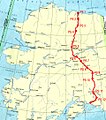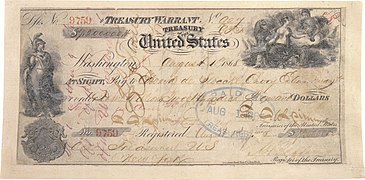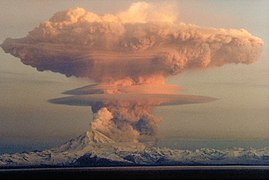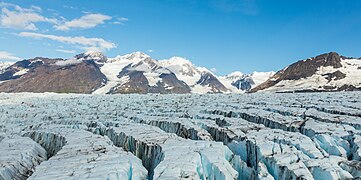 Introduction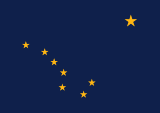   Alaska (/əˈlæskə/ ⓘ ə-LASS-kə) is a non-contiguous U.S. state on the northwest extremity of North America. It borders the Canadian province of British Columbia and the Yukon territory to the east; it shares a western maritime border in the Bering Strait with Russia's Chukotka Autonomous Okrug. The Chukchi and Beaufort Seas of the Arctic Ocean lie to the north and the Pacific Ocean lies to the south. Technically a semi-exclave of the U.S., it is the largest exclave in the world. Alaska is the largest U.S. state by area, comprising more total area than the next three largest states of Texas, California and Montana combined, and is the seventh-largest subnational division in the world. It is the third-least populous and most sparsely populated U.S. state, but is, with a population of 736,081 as of 2020, the continent's most populous territory located mostly north of the 60th parallel, with more than quadruple the combined populations of Northern Canada and Greenland. The state contains the second-largest and largest cities in the United States by area: the state capital of Juneau, and its former capital, Sitka, respectively. The state's most populous city is Anchorage and approximately half of Alaska's residents live within its metropolitan area. Indigenous people have lived in Alaska for thousands of years, and it is widely believed that the region served as the entry point for the initial settlement of North America by way of the Bering land bridge. The Russian Empire was the first to actively colonize the area beginning in the 18th century, eventually establishing Russian America, which spanned most of the current state, and promoted and maintained a native Alaskan Creole population. The expense and logistical difficulty of maintaining this distant possession prompted its sale to the U.S. in 1867 for US$7.2 million (equivalent to $157 million in 2023). The area went through several administrative changes before becoming organized as a territory on May 11, 1912. It was admitted as the 49th state of the U.S. on January 3, 1959. Abundant natural resources have enabled Alaska—with one of the smallest state economies—to have one of the highest per capita incomes, with commercial fishing, and the extraction of natural gas and oil, dominating Alaska's economy. U.S. Armed Forces bases and tourism also contribute to the economy; more than half the state is federally-owned land containing national forests, national parks, and wildlife refuges. It is among the most irreligious states, one of the first to legalize recreational marijuana, and is known for its libertarian-leaning political culture, generally supporting the Republican Party in national elections. The Indigenous population of Alaska is proportionally the second highest of any U.S. state, at over 15 percent, after only Hawaii. (Full article...) Entries here consist of Good and Featured articles, which meet a core set of high editorial standards.
 Alaska is a state of the United States in the northwest extremity of the North American continent. According to the 2020 United States Census, Alaska is the 3rd least populous state with 733,391 inhabitants but is the largest by land area spanning 570,640.95 square miles (1,477,953.3 km2). Alaska is divided administratively into 19 organized boroughs and one Unorganized Borough (which is divided into 11 non-administrative census areas) and contains 149 incorporated cities: four unified home rule municipalities, which are considered both boroughs and cities; ten home rule cities; nineteen first class cities; and 116 second class cities. Alaska's incorporated cities cover only 2.1% of the territory's land mass but are home to 69.92% of its population. The majority of the incorporated land mass consists of the four unified municipalities, each over 1,700 square miles (4,400 km2) in size. Only two other cities have an incorporated area exceeding 100 square miles (260 km2): Unalaska, which includes the fishing port of Dutch Harbor, and Valdez, which includes the terminus of the Trans-Alaska Pipeline System. Incorporated cities in Alaska are categorized as either "general law" (subdivided into "first class" and "second class") or "home rule". In general, the powers and functions of general law cities and home rule cities are substantially the same, with all legislative powers not prohibited by law or charter. Apart from duties such as conducting elections and holding regular meetings of the governing bodies, the duties of local cities vary considerably and are determined at the local level. Home rule cities and first class cities in the unorganized borough must operate municipal school districts, exercise planning, and land use regulations while organized boroughs take on these responsibilities unless delegated to the city by the borough. Unified home rule cities (and other boroughs) also have the duty to collect municipal property and sales tax for use in their jurisdiction. Home rule cities occur when a community establishes a commission to draft a charter, which is then ratified by voters at an election. Title 29 of the Alaska Statutes, which covers municipal government, requires that a community must have at least 400 permanent residents to incorporate as a home rule or first class city. This status does not diminish if a city's population declines; one home rule city (Nenana) and four first class cities (Hydaburg, Pelican, Seldovia and Tanana) reported populations falling below that threshold in the 2010 Census. The largest municipality by population in Alaska is Anchorage with 291,247 residents or approximately 39.7% of the state population. The smallest municipality by population is Kupreanof with 21 residents. The largest municipality by land area is Sitka which spans 2,870.34 sq mi (7,434.1 km2), while Kiana is the smallest at 0.19 sq mi (0.49 km2). The first city to incorporate was Ketchikan in 1901 and the newest municipality is Whale Pass which incorporated in 2017. (Full article...)TopicsCategoriesSelected article -Star Air Service, later Star Air Lines and Alaska Star Airlines was an American air service in Alaska from 1932 to 1944. With financial help from a wealthy Alaska miner, three pilots who had started a flying school and charter business in Seattle, shipped an open-cockpit biplane by steamship to Alaska in March 1932. Star Air Service was incorporated in April, 1932 in Anchorage with capitalization of $4,000. The company had some early success training student pilots, but their airplane was destroyed in a crash. Their financial backer helped them purchase a larger plane with an enclosed cabin which supported winter operations. Three air services were founded in Anchorage in 1932. There was a surplus of airplanes, and not enough business to support them all, which prompted the 1934 merger of McGee Airways with Star Air Service. Star became the largest carrier in Alaska. A lack of financial resources and poor management continued to haunt the company. One of the founders lost his pilot's license and another died in a plane crash in 1936. With a change in management, the company was sold to a new group of investors in 1937, and renamed Star Air Lines. Government regulation of Alaska airline routes which began in 1938, along with continued financial instability of Alaska's air carriers prompted a consolidation within the industry. In 1942, Star Air Lines was purchased by New York City businessman Raymond Marshall. (Full article...)Selected picture -General imagesThe following are images from various Alaska-related articles on Wikipedia.
Recognized contentFeatured articlesGood articles
Featured pictures
Former featured pictures
Related Portals
Related WikiProjectsState facts
State symbols:
Tasks
Associated WikimediaThe following Wikimedia Foundation sister projects provide more on this subject:
Discover Wikipedia using portals |

Sons of Union Veterans of the Civil War















